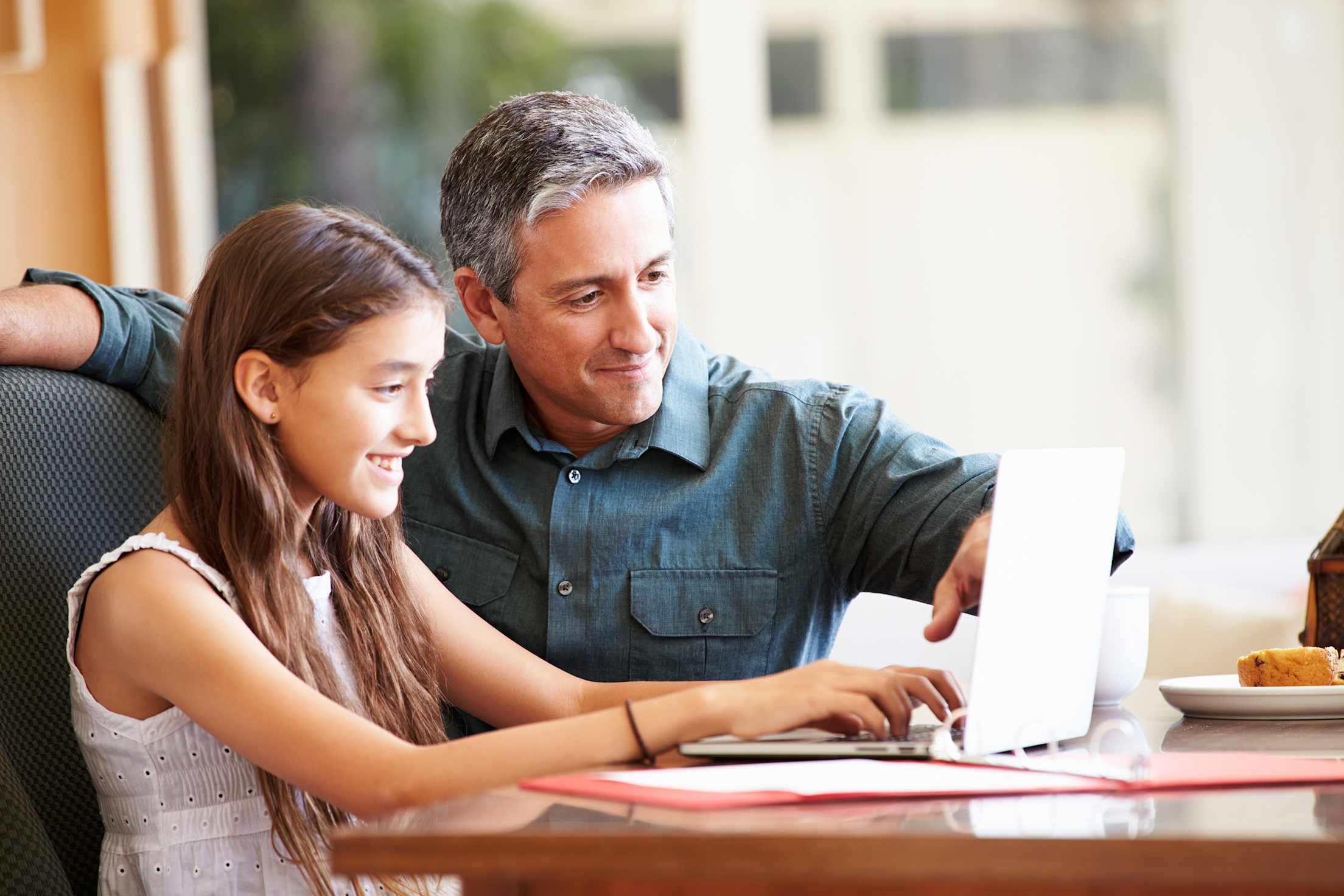
How to Teach Your Kids Good Money Habits
Financial learning starts at home.

For many adults, talking about money is rare and often uncomfortable. Even close friends and family may not be privy to salaries, investment strategies (or lack thereof), or other personal finance details. But when it comes to your kids, being open about money can help set them up for a better financial future as adults.
“Children do not learn much about personal finance at school, so it’s up to parents to teach the basics,” says Kimberly Palmer, NerdWallet's personal finance expert and author of Generation Earn.
Kids who are part of everyday conversations about money gain a powerful edge when it comes to financial security later in life—they get insight into important money concepts (think: not being able to buy everything you desire, saving, investing, and so on) and also cement good habits. A survey from investment firm T. Rowe Price found that 64 percent of kids whose parents talk about financial matters on a weekly basis feel they’re smart about money.
“When you teach kids the nuts and bolts and share your money values, your child is going to be more financially successful,” says Carrie Schwab-Pomerantz, CFP®, a financial literacy expert with Charles Schwab. That success is not about wealth, she says, but rather, about gaining confidence. Instead of being intimidating or overwhelming, the tactics required to manage money—from setting a budget to saving and investing—will feel familiar. Plus, Schwab-Pomerantz notes, studies show that “kids want to learn about money and they think it’s fun.”
But how can you teach kids about money in an age-appropriate way? And what are the most important concepts to share? Read on for tips from financial experts about how to instill good money habits in children of any age.

Loose change is a great learning tool for school-aged children.
Start with the fundamentals.
You don’t have to be Warren Buffett to give your child a solid foundation in the basics of money and personal finance. Here are the fundamental concepts your child should understand by the end of their teen years:
- What’s money? Starting at a young age, introduce kids to the concept of money and how it’s earned and used to make purchases.
- Budgeting and saving: Being able to live within your means is important for everybody. Think of a budget as a plan. It’s “a general outline of how to get from where you are to where you would like to be financially,” according to the National Endowment for Financial Education’s High School Financial Planning Program. For kids, a budget may help them save for a pricey toy, while in adulthood, the same tactics will allow them to make responsible purchases, save a down payment for a home, and more.
- Investing: Just as you want to save for purchases, it’s also important to invest for the future, notes Schwab-Pomerantz. As kids hit middle school and beyond, you can introduce them to the concept of investing.
- Debt: Talk to kids about how debt can be a useful tool to potentially increase wealth (as with a mortgage) or earning power (as with student loans), says Schwab-Pomerantz. For older kids, this may mean talking in detail about student loan debt. You can also introduce kids to the concept of credit, which allows you to purchase something now, and pay for it in the future.
- How to know when something is too good to be true: Schwab-Pomerantz notes this is an important concept. “So many people today are taken advantage of,” she says. You want your children to be savvy, so they can avoid scams and evaluate financial offers and opportunities.
Childhood is also a time to share your family's money values, whether it's giving back, living within your means, having a strong work ethic, prioritizing savings, or something else. “Money values are personal and need to resonate with each family,” says Carrie Friedberg, a San Francisco-based certified financial coach.
Keep it age-appropriate.
Of course, you won’t talk to your two-year-old about the importance of contributing to a 401(k). But do start demonstrating and discussing financial concepts, such as budgeting and planning, early on.
Say you’re weighing the trade-offs for going on a vacation versus putting more money in a college savings account. Do it when your kids are around, instead of after bedtime. “Talking about that out loud at the dinner table can be a useful way to let your children see how you’re making those choices,” Palmer says. Just be sure to keep conversations and money-based activities age-appropriate, cautions Friedberg. Discussing if you’ll make a purchase and how you’ll do so is informative, but sharing worries about job loss or not having enough money to pay the bills are adult matters. "It’s important for parents to tread lightly," Friedberg says—you don't want to make kids anxious.
Make sure not to change how you talk about money—or what you cover—based on your child’s gender. “We inadvertently leave our girls out on important conversations around investment and debt management,” says Schwab-Pomerantz.

A piggy bank can be a helpful teaching tool.
Teach preschoolers what money is and how it works.
“Like every other life skill, good money habits can be taught starting at an early age,” says Friedberg. That learning can begin for preschool-aged children. Here are some tactics to introduce money to young kids.
Introduce money basics.
An everyday trip to the store or putting away groceries can be educational, notes Sesame Workshop, a nonprofit aimed at helping young children. You can point out the prices on food, talk about what the family needs, and so on.
Use a piggy bank.
Give your child a jar or piggy bank to collect coins, says Friedberg. This habit can start as young as age two, she says—just be careful to supervise to avoid choking concerns. Starting at around age four, you can explain the names and values of the coins, and then encourage kids to count them, says Friedberg. Ask kids: How many coins do you have? How many dimes? How many quarters?
Differentiate between wants and needs.
Very young kids are often full of wants, notes Palmer. Introduce the notion that it’s not possible to get all your wants, and help kids understand the difference between something they want and something they need. You can try doing this by asking questions based on their favorite books and TV shows, suggests Sesame Workshop. For instance, ask your child if Elmo wants ice cream or needs ice cream. Talk about making choices, too, by asking them to pick one toy to bring along in the car or when you’re at the store considering a purchase. “As parents, we can teach our kids how to weigh the pros and cons of different decisions,” says Palmer—and this is a conversation that can continue through life.

Talk to your kids about family purchases.
Give elementary and middle school kids first-hand experience.
Once your child is in school, you can have more sophisticated conversations and teach them to manage their money.
Bring kids along.
Weighing a big-ticket purchase? Involve your kids. A trip to the car dealer—and listening in on the conversations leading up to the purchase—is an opportunity to show kids how you compare prices or other financial processes that are part of everyday life, says Palmer.
Introduce meaningful savings.
Have your child divvy up the money in their piggy bank into three jars: one for savings, one for spending, and one for giving, says Friedberg. Earmarking some money to donate (either a few times a year, or annually) helps plant seeds of gratitude and generosity, says Palmer.
Open a savings account.
As kids get older, the piggy bank can grow up too. You can go with your child to the bank and open a savings account, says Schwab-Pomerantz. Make sure the kids come along: That way, they’ll get familiar with interacting with the customer service person and the teller, see what it’s like to fill out the paperwork, and so on, she says. This helps demystify the bank and basic financial services, Schwab-Pomerantz says. You can fund the account with birthday money and built-up allowance savings.
Smart tip: Look for a savings account that has a high interest rate, no minimum balance requirement, and no monthly maintenance fees.
Give an allowance.
“Give an allowance when the child is old enough and mature enough to manage the money,” says Schwab-Pomerantz. The amount matters less than the weekly ritual and the opportunity to discuss money with your kids, says Palmer. Once kids have an allowance, you can have them start spending some of their own money on things they want, Schwab-Pomerantz says. This introduces kids to the concept of budgeting and the power of saving money. Kids start to see how handling money involves many choices.

Much like teaching your teen to drive, it can be helpful to slowly introduce new skills and build confidence together.
Encourage teens and young adults to be more independent.
During high school and college, offer guidance and support, but allow your child to control their money. Sometimes, this will lead to mistakes. That’s OK! “The reality is that some of the best learning young adults experience is by making their own mistakes when the stakes are low,” says Friedberg.
Introduce debit and credit cards.
If your child doesn’t already have a checking account, encourage them to open one and use a debit card for purchases. This way, they’ll get accustomed to swiping or using their phone to pay, but understand that the debit card will deduct money instantaneously from their account.
High school can be an appropriate time to add your child to a credit card as an authorized user, says Palmer. (It’s a good idea to make sure the credit limit is low.) This way, they’ll start to get the basics of using a credit card: interest rates, fees, a monthly bill, the importance of paying off the full balance, and so on. “It’s a credit card on training wheels,” says Schwab-Pomerantz. Try getting kids acclimated to credit card usage before they go to college or leave home.
Consider an investment account.
Forty-two percent of adults aged 18 to 29 had no retirement savings in 2018, and a quarter of all adults have no retirement savings or pension according to a report from the U.S. Federal Reserve. While working teens can open an IRA, Schwab-Pomerantz recommends having your teen start a mutual fund investment account so they can better learn how the market works, experiment, and gain confidence by investing small amounts (under $100).
Again, bring your child to the bank or open the account online together. If you go in person, financial consultants are happy to run through the basics of long-term investments with teens, Schwab-Pomerantz says. Let young adults make their own choices—and their own mistakes, says Palmer. Teens may gravitate toward investing in a single company they know by name or associate with a much-loved product. Let them do it, recommends Palmer. “If they lose money, it can be a good lesson. When they’re older, and investing retirement money, they won’t make that same mistake,” she says.
Practice budgeting and make spending plans.
This activity is great for kids between the ages of 14 to 18, says Friedberg. You want to start early so they have the tools they need to confidently manage their money when they move out on their own. “Imagine a world where every parent taught their children to earn money; make a plan for spending, saving, and giving; track where their money went; and reconcile and reflect afterwards,” Friedberg says. By practicing these skills—with parents’ help and support, both emotionally and technically—kids can work to become “truly financially prepared for the adult world,” she says.